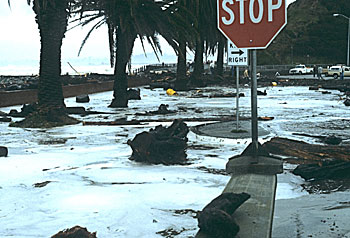By Gary Griggs, Distinguished Professor of Earth and Planetary Sciences, UCSC

Living in New Orleans or Venice, where the land is subsiding and adding to the rate of local sea-level rise, presents greater future risks than living in Juneau, Alaska, or Oslo, Norway, where the land is rising faster than sea level.
Looking more local, there is a lot of public infrastructure, as well as private development, around northern Monterey Bay that has been flooded or damaged during past El Niño events and/or periods of large storm waves combined with high tides. The El Niño winters of 1978, 1982-83 and 1997-98 provide us with some recent history that some readers saw and will remember.
The more the oceans rise, the further inland and the higher the elevations that will be reached by future very high tides, El Niño Events, and storm wave run-up. The areas flooded in the past will in all likelihood be the same areas flooded in the future, although with greater frequency.
What has become clear is that the rate of sea-level rise is increasing in response to the increase in global temperature. Additional warming is leading to the expansion of seawater and the melting of additional global ice. While the total amount of sea level rise equivalent that is tied up in glaciers and ice sheets is frightening, about 225 feet if it were all to melt, this is not likely to happen anytime soon.
Today there are about 150 million people around the planet living within 3 feet of high tide. The coastal megacities of Shanghai, Ningbo, Tianjin, Guangzhou, Tokyo, Hai Phong, Ho Chi Minh City, Jakarta, Bangkok, Yangon, Dhaka, Chittagong, Khulna, Kolkata, Mumbai, Lagos, Abidjan, Alexandria, Miami, and New York City, among the largest, will have a combined projected population of over 110 million people by 2070 exposed to sea-level rise.
In addition to the gradual rise in sea level we have been experiencing over the past century or so, scientists who study the ice shelves and glaciers of Antarctica and Greenland are concerned that increased warming may lead to collapse of a large ice shelf that will produce a rapid glacier surge into the ocean. One of these events could raise sea level several feet within a few years.
I believe we also tend to think that the impacts of sea-level rise are restricted to those people and cities directly on the coast, but some estuaries have tidal influence that extends considerable distances inland. Stockton and West Sacramento are ports that are served by ocean going ships and are affected by sea-level rise that extends as far as 85 miles inland from the Golden Gate.
The good thing and the bad thing about sea-level rise is that its been happening at a modest rate, at least so far. Good in that its not creating death and destruction except during extreme events; bad in that many politicians don’t believe its even happening, and others don’t see it as a hazard to worry about.
Fortunately, California has political leaders who continue to develop legislation responding to climate change and sea-level rise and many other states and nations look to us and often follow our lead.